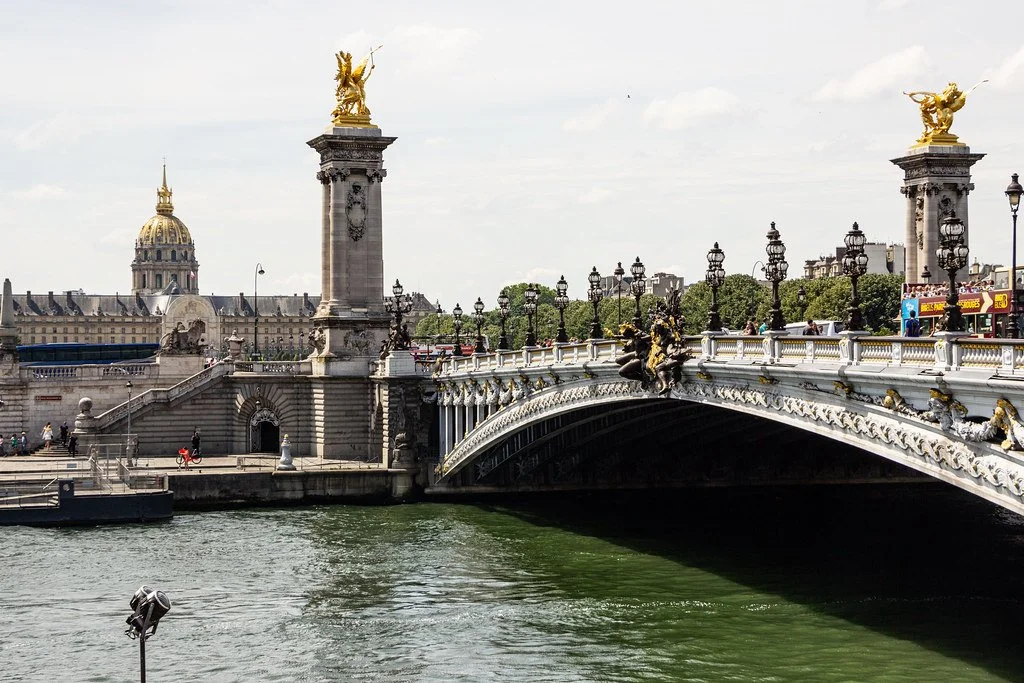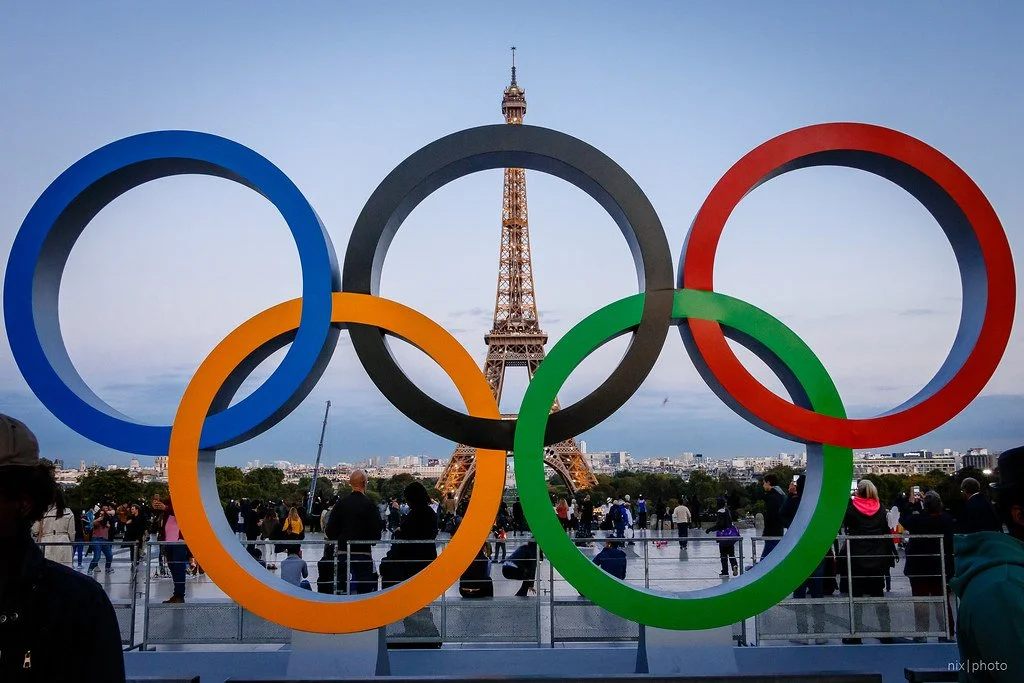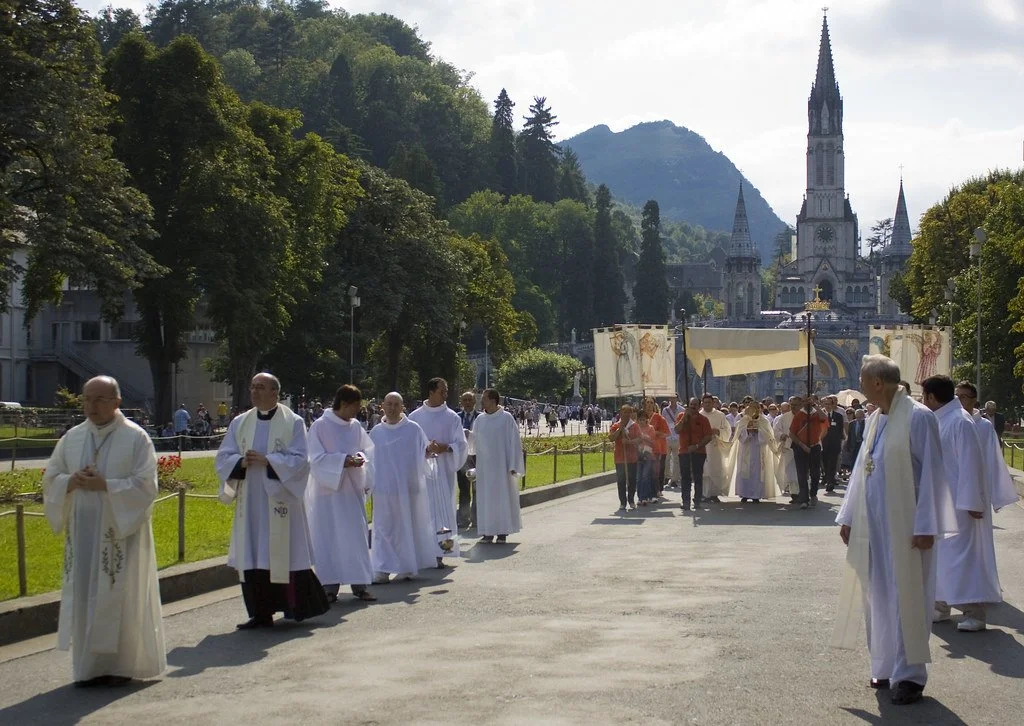In France, the debate on childfree hotels, restaurants, campsites and resorts is coming to a head.
Read More6 Best International Films Showcased at Cannes
From political thrillers to coming-of-age dramas, the 2025 Cannes Film Festival showcased stories about family, power, survival and more. Here are this year’s major award winners.
Read More2024 Paris Olympics: Challenges, Protests and Controversies
From transportation and public safety concerns in Paris to discontent in Tahiti, the 2024 Paris Olympic Games are riddled with contention.
The Eiffel Tower with the logo of the Olympic Games. Ibex73. CC BY 4.0 via Wikimedia Commons
As the countdown to the 2024 Olympic Games in Paris reaches its final days, anticipation is building among the estimated 15 million visitors set to descend upon the city. However, this year’s games are not without their share of controversies. Unrest and protests have begun to surface, not just from within the borders of France but also among the vast number of international travelers and athletes. These contentious issues are casting a shadow over the upcoming Games, adding a layer of uncertainty and complexity to an event traditionally associated with unity and the celebration of athleticism.
Security Concerns, Congested Transportation, Unhoused Parisians
The opening ceremony, scheduled to take place in the open air along the historic Seine River, has raised a number of security concerns. These concerns are particularly acute because of the memory of the terrorist attacks in Paris in 2015. Furthermore, ongoing geopolitical unrest, notably the war between Gaza and Israel and Russia’s continued aggression towards Ukraine, adds to the apprehension. In anticipation of potential protests, the French government has reduced the number of tickets for the public from 600,000 to 300,000 and plans to deploy around 45,000 French police and security forces. During the opening ceremony, an additional 35,000 security agents are expected to be on duty alongside the military to safeguard against security threats. The recent stabbing of a French counter-terrorism soldier over a week before the games are set to begin has only increased tensions.
Along with security concerns come concerns over the expected additional congestion of the city’s already packed public transport system. Many Parisians believe the transportation is largely underprepared for the influx of tourists as they already deal with poor frequency of trains, overcrowding, and general uncleanliness. Those who are financially able are electing to leave the city for the period of the games, while others will be forced to turn to alternative modes of transport and access such as biking, walking or telecommuting. Those who are unable to consider alternative transportation will have to endure long commutes with few alternatives. In response to criticism over transportation concerns, the French president of the Ile-de-France region, Valérie Pécresse, made a statement to worried citizens, "Don't be afraid to walk a little, it's good for your health".
The Olympics have also brought the plight of the city’s unhoused population to the forefront. The Olympic Village has been constructed in one of Paris’s most impoverished suburbs, an area where thousands of individuals reside in street encampments, shelters and derelict buildings. In a controversial move, the French government transported thousands of these unhoused individuals on buses to other French cities such as Marseille and Lyon. They were removed from the city under the pretext of promising housing elsewhere, only to find themselves living on unfamiliar streets far from their original homes. This action has drawn widespread criticism as it is in no way a permanent solution, but rather a means to conceal the city’s homelessness issue and present a more idyllic image of Paris. While the government denies any connection between this relocation and the Olympics, an email obtained by the New York Times and initially reported by L’Equipe reveals a government housing official stating the objective to “identify people on the street in sites near Olympic venues” and relocate them prior to the Games.
Water Sport Events
The Seine River, the chosen venue for the opening ceremony, will also host the triathlon and marathon swimming events. This decision has ignited controversy, as many Parisians view the river as polluted and unsafe. Swimming in the Seine has been illegal for over a century. In an effort to clean the river, Paris has invested $1.5 billion in infrastructure to prevent bacteria-laden wastewater from entering the river. Despite the clean up, experts are still uncertain if the river’s E. coli levels will be safe for swimming in time for the events, and no backup plan has been announced. In a show of confidence, President Emmanuel Macron and Paris Mayor Anne Hidalgo have vowed to swim in the river themselves to demonstrate its safety. Just this past Saturday, French Sports Minister Amélie Oudéa-Castéra took the plunge into the river.
In an unusual display of public anger, a distinctive form of protest seemed to be in the works for several weeks. Known colloquially as the ‘poop protest’, it called for citizens to deposit their waste into the Seine on June 23, 2024, strategically timed to coincide with the President’s original planned swim. Remarkably, an unidentified engineer had developed a website that calculates the exact moment for the waste drop-off, ensuring it aligns with the President’s swim based on the individual’s distance from the river. This protest concept was not merely a reflection of skepticism regarding the cleanliness of the Seine, but also a broader expression of French dissatisfaction with the President’s recent election gambit and the anticipated disruptions the Olympic Games are expected to bring to the city. The protestors seem to have been more bark than bite, however, because after Macron canceled his originally planned dip Oudéa-Castéra's swim took place nearly without incident; the Sports Minister slipped while getting in the water.
Meanwhile, in French Polynesia, Tahiti is set to host this year’s Olympic surfing events. Tahiti is a well-known destination for surfing competitions, and has been so for many years. The International Surfing Association (ISA) voiced its opposition to the construction of a new aluminum judges’ tower for the 2024 Olympics in Tahiti, amid concerns from locals and environmentalists about potential damage to the local coral reef. Despite the continued use of a wooden tower at Teahupo’o, one of the world’s most famous surf breaks, for the past 20 years, Olympic organizers and government leaders greenlit construction on a new tower due to safety concerns. The ISA had proposed more environmentally friendly solutions, such as building the tower on land and using digital cameras on the wooden tower, but these were rejected in favor of the new structure.
The controversy escalated from the first peaceful protest in October, with over 200,000 people signing an online petition against the tower and prominent surfers lending their support. An incident where a barge being used in the construction got stuck on the offshore reef further fueled local anger. Despite apologies from the president of French Polynesia, Moetai Brotherson, and assurances from Barbara Martins-Nio, general manager of the 2024 Paris Olympic committee based in Tahiti, that the barge incident was a mistake, the new tower was still deemed necessary for the competition. However, many locals, including the mayor of Taiarapu Ouest, stood by the belief that building the tower outweighed the costs. The protests failed, and the tower has since been completed.
As the 2024 Olympic Games in Paris approach, they carry the weight of numerous controversies and the hopes of millions of spectators, eager to participate in a global event of this magnitude for the first time since the COVID-19 pandemic. From security concerns and transportation issues to the treatment of the city’s unhoused population and environmental concerns, these Games are a testament to the complex interplay of sports, politics and society. Despite the controversies, the essence of the Olympics remains—unity, athleticism and global camaraderie. As the world tunes in, these Games will be a reminder of our shared love for sport and competition, and the collective challenges we need to address.
Julz Vargas
Julz is a student at Wellesley College studying Anthropology and Spanish. She grew up in Los Angeles, CA, and has studied all around the world in places such as Costa Rica, Greece, Iceland, and Spain. She is passionate about employing writing as a tool to explore human connection and diversity. Julz aspires to foster cross-cultural connections through community-based research, amplifying inclusive and diverse media about global cultures, foods, and people, to encourage individuals to engage more wholly with the world.
Dirty Water: The Frantic Rush to Clean the Seine Before the 2024 Olympics
Officials of the French government are trying to clean the Seine, which has been deemed unswimmable for a century, in time for the 2024 Summer Olympics swim competition.
Pont Alexandre III on the River Seine, Billy Wilson, CC BY-NC 2.0
With the 2024 Olympics set for Paris, the French government has faced backlash for its efforts to quickly clean the Seine, the main river that runs through Paris. The Seine is approximately 13 kilometers long and, in Paris, accompanied by 37 bridges. The staple has promoted water travel and inspired classic French songs such as, “Sous le Pont Mirabeau” and “Sous les Ponts de Paris.” The Seine also has a long history of supplying water to Parisians. In Medieval Paris, citizens and street vendors would collect water from the Seine before they had access to running water. In 1802, Napoleon constructed the Canal St Martin connecting the Seine to the Bassin de La Villette with the goal of supplying water via public fountains throughout the city. The River Seine was in wide use, with people engaging in walks along its banks and recreational swimming, until a decree was passed in 1923 that banned such activities due to pollution and waste runoff. News Writer Olivia Craighead explains that, “The city is old as hell, and as such, sometimes sewage ends up in the Seine.” While people are still allowed to visit its banks, the River Seine has been closed to swimmers since the decree. Until the announcement of the 2024 Olympics.
Since the 2008 Olympics, there have been two open water swimming events: the triathlon and the 10k marathon swim. Pierre Rabadan, the deputy mayor in charge of sports, Olympics, and Paralympics, has said that, “Our objective is an Olympic legacy.” In 2015, Paris introduced the "Plan Baignade" (“Swimming Plan” in English), a plan to make the river swimmable for the Olympics and regular citizens by 2024. As a result, the government has invested upwards of $1.5 billion to make their plan a reality. Despite their efforts, test results from the week of June 10 reveal that E. coli levels in the river are over twice the maximum allowed in water for Olympic events. Marc Guillame, a top government official for Paris, says that these recent readings “are not in line with the standards we will have in the summer.” With the Seine, most bacteria is killed with sunlight and warm temperatures, both of which Paris has seen very little of at this point in the summer. Instead, it has endured heavy rain and cloudy conditions. Phillippe Leclercq, an 18 year old living on a houseboat on the River Seine, notes that, “When it’s good, it’s a nice green color, lately it’s just been brown.”
To ease concerns citizens and athletes have about the River Seines’ cleanliness, President Emmanuel Macron and Mayor of Paris Anne Hidalgo have pledged to be the first swimmers. Originally scheduled to take a dip on June 23, the two have moved their swim back to July 14. Hidalgo stresses that this was not due to the condition of the water, but the current weather and political atmosphere: “Yes, I will swim in the River Seine, not now because the weather is not so well in Paris, but also because we have an election. It is not possible to organize the jump to the river during the election.”
Aanya Panyadahundi
Aanya is a student at the University of Michigan studying sociology and journalism on a pre-law path. She loves to travel the world whenever she can, always eager to learn more about the different cultures and societies around her. In her free time, she likes to play the violin, ski, and listen to podcasts
Surfing at 2024 Olympics Destroys Coral Reefs in Tahiti
Teahupo’o locals and scientists protest the building of 2024 Olympic Games infrastructure over environmental and economic concerns.
Surfing in French Polynesia. Duncan Rawlinson. CC BY-NC 2.0 DEED
In preparation for the 2024 Olympics, Paris has placed sustainability at the heart of its environmental ambitions. In keeping with the city's aim to “assume its responsibilities” for the games' environmental and social challenges, there have been many contributions to fight carbon impact, food waste and destructive construction. However, organizers have recently faced backlash for the erection of an aluminum tower in Tahiti, built specifically for the new surfing competition, that has damaged both coral and the competition's reputation.
To take the games to new heights, Paris has decided to host a new surfing competition, set to take place in Teahupo’o, Tahiti. This setting will offer the opportunity to host a unique competition and allow France to engage with its overseas territories. Teahupo’o, described as a paradise and dream spot by surfers and travelers alike, is anticipated to bring fans and athletes together. This influx of people to the island has called for the construction of a new venue; a 14 ton aluminum tower with concrete foundations, set to host 40 people judging and televising the competition.
Coral Reefs in Tahiti. Jeremy H. CC BY-NC-ND 2.0 DEED
On 1 December, a barge intended to help build the tower got caught on a reef and damaged local coral. Save Teahupo’o Reef, a group made up of locals, surfers and NGOs, posted a video showing the broken coral and damaged boat propeller on their Instagram. After this initial damage, work was stopped to find a small barge and better route for it so as to not damage any more coral.
Plans to build the tower have been met with more resistance from locals in the form of social media campaigns or protests. Residents have fought against the construction, claiming that building it risks impacting the marine ecosystem and damaging the coral reef. Scientists based in Hawaii have advocated with locals and defended their call to stop building the tower, citing its environmental impact. Using 3D photogrammetry techniques, the researchers created maps of the reef habitat where the tower is set to be built and of the lagoon that its materials will be transported through. Their findings indicate that Teahupo’o would face devastating effects. Of the 3,500 square feet that this development would impact, there are over 1,000 corals from 20 different species. The cost of this dredging and building is estimated at $1.3 million. One of the scientists, Dr. Burns, offered no recommendation for construction that would minimize reef damage as there will be substantial damage regardless of alterations to the process. He suggested alternative solutions to broadcasting the games that included a judge in a boat, using drones or playing a live video feed, all of which are more cost-effective, environmentally friendly and presumably better aligned with the ambitions of the organizers.
Efforts to protest the tower have primarily come from groups like Association Vai Ara o Teahupo’o, who have created an online petition that has garnered over 223,000 signatures. The group is composed primarily of locals who rely on the marine environment for their livelihood and feel it is an important part of their heritage that they would like to preserve.
Coral Reefs in French Polynesia. Adam Reeder. CC BY-NC 2.0 DEED
Following the barge incident, the Olympic Committee made the decision to reduce the size of the tower by 25%. To decrease the weight placed on the foundations, the weight has been reduced from 14 tons to nine and will instead be installed at the same site as the old wooden tower. The original design required 72 four meter tall rods that would be drilled into the reef, but as a result of the now smaller design, rod length will be shortened so as to not be driven down as far. The tower is also being built in an area with fewer corals, and existing ones will be removed and taken care of to ensure regrowth.
Despite growing concern over the risk posed to marine life, there will be some benefits of the event after the games conclude. These include new infrastructure such as a pedestrian bridge, fiber internet cables and the money brought into the local economy by those renting places to stay for the games.
Paris has certainly given more thought to sustainability efforts relative to other Olympic hosts, and has certainly made concerted efforts to reduce the games' environmental impact. However, it is important to recognize the destruction that the tower has caused and the long-lasting effects that it will have even after the games end. If Paris does intend to follow through on its sustainability goals, it must ensure that the Teohupo’o reef is left undamaged not just for the short duration of the games, but even after they end. In doing this, Paris and the organizers of the games would prove themselves dedicated to both sustainability and the island's people, bringing about a new era of true environmental conservation.
Mira White
Mira is a student at Brown University studying international and public affairs. Passionate about travel and language learning, she is eager to visit each continent to better understand the world and the people across it. In her free time she perfects her French, hoping to someday live in France working as a freelance journalist or in international affairs.
Will the Paris Olympics Be the Green Games?
In preparation for the Olympic Games, Paris invests in sustainable resources to minimize environmental impact.
Paris Olympic Games. Nicolas Michaud. CC BY 2.0
Keeping up the momentum of its previous environmental ambitions, Paris has committed to complete environmental sustainability for the 2024 Olympic Games. This greener approach will be made possible through careful consideration of the event’s chosen venues, operations (catering and accommodation) and transportation.
As a city renowned for its architecture, Paris has addressed one major change that it can make to the games — using existing infrastructure to host events. As of now, 95% of the chosen venues are pre-existing or temporary structures.
The competition zones are divided into two main areas both inside and outside of Paris’ center. Universally connected by the Seine, 80% of the venues are within a 10 kilometer distance of the Olympic and Paralympic Zones, allowing 85% of athletes to stay less than 30 minutes away from their venue. Through the use of existing facilities that require minimal transportation, Paris can host an event that will aid in its goal to, hopefully, halve a previous carbon footprint of 3.86 million tons. The French aim for a decrease in emissions compared to that of the Tokyo Games in 2020. With Tokyo’s post-game estimation of 2.16 million tons of carbon dioxide, Paris has committed to a limit of 1.65 million tons and to offset any indirect impact with climate-positive projects. Meeting carbon emission goals for the games may prove challenging because of these indirect impacts, primarily the substantial travel emissions generated by spectators. This seems a daunting task when compared to the Tokyo games which managed to achieve low net emissions because of the lack of spectators due to the COVID-19 pandemic.
In accordance with the city’s holistic sustainability vision, Paris has placed emphasis on the importance of green catering. As an event that is responsible for serving 13 million meals, embracing sustainable food sources and partnerships now will set the city up for environmental prosperity even after the games.
In recognizing the environmental impact of certain food sources and resulting waste, Paris has quantified its objectives to reduce its carbon footprint. This eco-conscious catering approach is made up of 6 commitments: two times more plant-based food, 100% certified food (food that is sourced, produced and consumed in a responsible way), reduced plastic consumption, recycling of all uneaten food, reuse of all equipment and structures and hiring 10% of workers from professional integration programs. Athletes and spectators will have a wide variety of plant-based options at their disposal, with 60% of food and beverages available to spectators being vegetarian. With 80% of the total food supply being sourced from within France’s borders, the alternatives to traditional cuisine should hardly be noticed as food will be prepared by culinary professionals who are familiar with creating meals that make the best use of the seasonal menu. Expertise from the chefs and localized sourcing will leave little room for waste across both food and its packing. In its drive to cut down on single-use plastic, Paris’ catering teams will exercise the use of plastic alternatives and employ a “reducing, reusing, replacing and recycling” concept on drink and food containers.
Paris’ goal to minimize waste generation and increase localized food sourcing encourages a healthier lifestyle that will extend beyond the games and become a beacon for environmental change. Even during the 2016 Olympic Games in Rio de Janeiro, plastic in the Guanabara Bay made it difficult for sailing teams to compete. This problem only intensified after the games when produced waste registered at over 18,500 tons, most being non-renewables. Despite this, some of the food waste after those games was utilized by an Italian chef, who created meals for the homeless.
The Paris Olympics will not focus only on breaking athletic records, but on breaking new ground for environmental action, particularly in sustainable event management. Through reliance on a well-developed, effective public transit system and localizing operations within France to minimize travel distance, Paris is showcasing a dedication to environmental impact that will extend beyond the games. If successful, this will serve as an inspiring example for how a large-scale international event can align with sustainability goals to change not just experiences, but lifestyles.
Mira White
Mira is a student at Brown University studying international and public affairs. Passionate about travel and language learning, she is eager to visit each continent to better understand the world and the people across it. In her free time she perfects her French, hoping to someday live in France working as a freelance journalist or in international affairs.
A Pilgrimage to Lourdes: Why a Tiny Town in France Attracts so Many Visitors
Every year, 6 million pilgrims descend upon the town of Lourdes. Explore how the town’s history and developments in the Catholic Church made it so popular.
Lourdes Eucharistic Procession. Lawrence OP. CC BY-NC-ND 2.0.
In 1858, 14-year-old Bernadette Soubirous, purportedly saw visions of the Virgin Mary by a spring in Lourdes, a tiny French town in a remote corner of the Pyrenees Mountains. It was almost unbelievable that the Virgin Mary decided to reveal herself to Soubirous, a poverty-stricken, sickly, illiterate girl. The town was immediately thrown into upheaval, with some questioning the veracity of the apparitions and others trying to see the sight themselves. Nobody else besides Soubirous ever saw the apparitions. But the spring besides the Grotto where she saw the apparitions was later revealed to have healing powers. The town was put on the map, and pilgrimages started soon after, continuing to this day.
The story of how Lourdes became so popular is intricately linked to the developments in the Catholic Church. After the horrors of the French Revolution, Catholics found solace in miracles, pilgrimages and processions. The 19th century was an era of Catholic revival, with an increase in devotion to the Virgin Mary. In 1854, Pope Pius IX proclaimed the dogma of the Immaculate Conception of Mary, meaning Mary was preserved from original sin. The appearance of Mary just four years after that proclamation threw the town into great excitement. The apparitions at Lourdes and the subsequent pilgrimages fit into the pattern of Catholic revival of the time.
That century also saw the consolidation of papal power in Rome. Papal authority became more prominent as Catholics became increasingly loyal to Rome. While there were other alleged Marian apparitions reported in the 19th century, Lourdes became the most famous because it had the Vatican stamp of approval. Pope Pius IX declared Lourdes an official pilgrimage site in 1876, demonstrating the increasingly tight link of remote villages to Rome.
The pilgrimages to Lourdes also reflect the expanding reach of the globalizing Catholic Church. Pilgrims going to Lourdes were not limited to Europeans; they came from all over the world. According to John T. McGreevy, a Bengali journalist made the trip to Lourdes and found “infallible proof” of God. Vietnamese soldiers in France during World War I toured Lourdes soon after their arrival. The diverse group of people who visit Lourdes show that the Catholic Church has become a transnational institution.
Lourdes Grotto. Kecko. CC BY 2.0.
Not only did the diverse array of visitors reflect the globalization of the Catholic Church, but the export of Lourdes to places around the world proved the same. Not long after people first became fascinated with Lourdes, aspects of Lourdes diffused to the home countries of visitors. The result was the creation of numerous replicas of Lourdes Grottos around the world, from the Vatican Gardens to Northern Indiana to Aruba.
Today, Lourdes is a vibrant community—much more than the sleepy village of 1858—that attracts 6 million visitors annually from around the world. But tradition is still observed. Catholic Masses take place daily in the Sanctuary of Our Lady of Lourdes, and processions are still a common occurrence. People bathe in the water from the springs, hoping for a miraculous healing. Despite the global reach of the village of Lourdes, it still manages to preserve the Catholicism that brought it to fame.
Bryan Fok
Bryan is currently a History and Global Affairs major at the University of Notre Dame. He aims to apply the notion of Integral Human Development as a framework for analyzing global issues. He enjoys hiking and visiting national parks.
Abuse in France’s Catholic Church: Report Finds Victims Number More Than 200,000
An independent commission found that for the last 70 years, hundreds of thousands of children were abused by clergy in France, and the church was ill-equipped to respond to and prevent abuse.
“Notre Dame, Paris.” Gary Campbell-Hall. CC BY 2.0
The Independent Commission on Abuse in the Church (CIASE) was published after an extensive three-year investigation. The report found that over 200,000 minors were abused by clergy members of the Catholic Church in France alone from 1950 to the present day. Furthermore, the commission estimated that, including laypersons who were employed by the church, such as staff in Catholic schools, the number of victims rose to 330,000 over the years.
The report also found that while family or friends in France perpetrated the highest rate of sexual violence against minors, the Catholic Church is the second environment with the highest prevalence of sexual violence. The report estimates that the number of perpetrators ranges from 2900 to 3200. While this number may seem low for the number of victims, the commission notes that “scientific research shows that a sexual predator can effectively assault a great number of victims, especially predators of male children- as is overwhelming the case in the Catholic Church.” The Vatican released a statement that the Pope learned of the report’s staggering findings with “sorrow.” Pope Francis stated, “I would like to express to the victims my sadness… my sorrow for the trauma that they have suffered. And also my shame” in response to the report’s findings.
The report found that the Catholic Church did little to prevent the abuse over the last 70 years, stating, “The Catholic Church’s attitude has evolved over time but it has remained too focused on the protection of the institution, for a long time with no regard to the victims.” Furthermore, the commission found that from 1950 to 1970, the church was focused on avoiding scandal and often saved aggressors by silencing victims. The report found that while the institution did not accept the violence, it was too focused on preserving the institution and did not know how to prevent or address the abuse. The commission urges the Church to not just move on from past abuse, stating: “ It is not enough for the Church to claim awareness, albeit too late in the day.” CIASE also said that the church needed to recognize the abuse, and take responsibility and begin a process of compensation.
The report also addresses canon law, finding that victims have “no place” in the law that was unprepared to deal with sexual violence. The report also cited deviations in catholicism where priests are almost elevated to saint status. The over-emphasization of obedience and purity could lead to environments that perpetuate sexual violence.
The CIASE report is not the first of its kind, but change within the Church seems to be slow. The head of the inquiry, Jean-Marc Sauvé, told reporters that until the 2000s’ the church had shown “deep, total and even cruel indifference" towards the victims of sexual abuse.
Dana Flynn
Dana is a recent graduate from Tufts University with a degree in English. While at Tufts she enjoyed working on a campus literary magazine and reading as much as possible. Originally from the Pacific Northwest, she loves to explore and learn new things.
Maurice the Cockerel: an Unexpected Symbol of the Fight for Rural France
One French couple filed a lawsuit against the owners of Maurice, a rooster, whose piercing call at 6:30 am disturbed their peace. The case sparked outcry all over the French countryside.
Read MoreFrance Banned Food Waste in Supermarkets
Millions more meals can reach those who need them.
Produce at a market in Nice, France. M-Louis. CC BY-SA 2.0.
In 2016, France banned supermarkets from destroying or discarding unsold food products, requiring them to donate instead to food banks or local charities.
The law was written by Parliamentarian and former food industry minister Guillaume Garot, who believes that food waste is a national health and safety issue, akin to wearing a seatbelt. The campaign itself was the product of a grassroots movement by anti-poverty and food waste activists which eventually became a petition, lead by local councillor Arash Derambarsh.
Now that food waste has been outlawed in French supermarkets, Derambarsh has set his sights on European and ultimately global policy revisions around the issue. “Food is the basis of life, it is an elementary factor in our existence,” he told the Guardian.
While Derambarsh became a councillor to help people, he reports being called “naive and idealistic” because of the policy he hoped to implement surrounding food waste. “Perhaps it is naive to be concerned about other human beings, but I know what it is like to be hungry,” he said.
“When I was a law student living on about €400 a month after I’d paid my rent, I used to have one proper meal a day around 5pm. I’d eat pasta, or potatoes, but it’s hard to study or work if you are hungry and always thinking about where the next meal will come from.”
Now, grocery store managers in France with a 400 sq meter or larger footprint must sign contracts with local charities and food banks promising their edible expired items, or face a €3,750 ($4,500) fine per infringement.
According to Jacques Bailey, head of Banques Alimentaires, a network of french food banks, 5,000 charities rely on food banks, who in turn, receive almost half their donations from grocery stores. Under the law, these food banks are receiving larger amounts of better quality food products, enabling them to better reach the the people they serve. According to Bailey, an increase as small as 15% in donations from supermarkets will result in 10 million more meals served every year.
And yet, required donations are not the only way that France is fighting food waste. In 2014, Intermarche, one of the country’s supermarkets began selling produce that was deemed too “ugly” to sell at other markets. These “ugly” or misshapen produce are perfectly safe to eat, but have blemishes make them less marketable to consumers, resulting in their disposal before even seeing the grocery store isles. This initiative is particularly effective, as fresh fruits and vegetables are the most difficult items for charities and food banks to come by, and are necessary to a healthy diet. Intermarche’s initiative reached 13 million people after only one month of being implemented.
About a third of food produced is wasted worldwide. France has narrowed the food it wastes to 66 pounds per person every year. In comparison, Americans waste 200 billion pounds of food per year - 40% of all food produced in the country. The waste problem in America is partly due to the lack of regulation surrounding expiration dates, which are often selected at random and do not always reflect when items are safe to consume.
The rest of the world has a lot to learn from France’s policy. NPR writes that communities and governments worldwide are now reaching out to Garot, hoping for information that would help them reproduce France’s law in their own countries. Ultimately this change needs to be made, because, as Garot emphasized, supermarkets are not just businesses, they are places where humanity must be respected.
EMMA BRUCE is an undergraduate student studying English and marketing at Emerson College in Boston. While not writing she explores the nearest museums, reads poetry, and takes classes at her local dance studio. She is passionate about sustainable travel and can't wait to see where life will take her.
Author provided
After the Niqab: What Life Is like for French Women Who Remove the Veil
Islamic headscarves and veils continue to be the subject of intense debate in Europe. Countries’ approaches toward the burqa and niqab, which cover the face, range from tolerance in the UK to an outright ban in France. Reactions of Muslim women to restrictions have varied, including protests by some, reluctant acceptance by others and also support for bans.
But what happens when a woman who has worn a niqab, sometimes for years, makes the decision to leave it behind?
Hanane and Alexia – whose names are pseudonyms to protect their identity – were both born in France. Hanane grew up in a non-practicing Muslim family, while Alexia converted to Islam at age 22. For five years they both wore a niqab. Hanane began in 2009, just before France banned the full-face veil, while Alexia adopted it later. Once ardent defenders of the right to wear the niqab, both women have now completely abandoned it. But the transition took place gradually and was accompanied by a growing distance from extreme Salafist ideology.
Hanane today. Agnès De Féo
‘Start living again’
On January 10, during the New Year’s discount sales in France, Alexia and I met near Paris’ Gare du Nord train station. She wanted to buy clothes and “start living again”. In the first shop she bought four slim pairs of pants and a trim jacket. She then tried out some Nepalese clothes designed for Western tastes, including a colourful jacket and pants with huge bell bottoms.
As she came out of the dressing room, Alexia gauged herself in front of the mirror: “It’s really me, I finally feel like myself again after years of being locked up.” With her hair brushing her face, she looked like a modern woman, fully alive. I was impressed with her metamorphosis: it’s hard to imagine that she wore a niqab for five years and was one of the most radical women I’d ever met.
I met Alexia in August 2011 in the context of my research on the full-length veil during a demonstration by the Salafist group Forsane Alizza(literally Knights of the Pride) in a city near Paris. She was wearing a niqab and presented herself as the wife of one of the group’s leaders.
Event of the Salafist group Forsane Alizza in August, 2011. At the centre is its leader, Mohamed Achamlane, who was jailed in 2015 for criminal conspiracy in connection with a terrorist enterprise. Agnès De Féo, Author provided
Alexia remembers that time:
We considered all Muslim supporters of the French Republic to be unbelievers. We were doing the takfir (excommunication) against those who did not practice like us. We were opposed to the taghout (idolatry in the broad sense), i.e., the state and institutions. We defined ourselves as ghûlat, which means ‘extremists’ in Arabic.
Estimates of the number of women who wear the niqab vary widely, from a few hundred to several thousand. In terms of even France’s Muslim population the percentage is tiny.
Hanane, whom I met on the side-lines of a demonstration in front of the French National Assembly, 2010. Agnès De Féo, Author provided
‘The niqab was protecting me’
I’ve known Hanane even longer than Alexia. We met during a January 2010 demonstration of women in niqab at the Place de la République in Paris and then in front of the National Assembly. She and others were protesting a proposed measure that would outlaw concealing one’s face in public.
At the beginning of 2017, Hanane reached out to ask me to help her write a book about her life. In the book she’d like to write, Hanane doesn’t want to denounce the niqab, but to tell the story of the rapes she says were repeatedly inflicted by her father-in-law. To her, they help explain her involvement in Salafism.
Religion brought a lot that helped me escape from the trauma of rape. I was 19 to 20 years old when I started wearing the niqab, I took it off when I was 25. The further I went, the more I wanted to cover myself. The niqab protected me, I liked hiding from men. I could see them, but they couldn’t see me.
Unlike Alexia, who decided on her own to begin wearing a veil, Hanane remembers the influence of her social circle at the time:
We were a bunch of girlfriends and wore niqab almost all at the same time. In our group the earliest was Ayat Boumédiène, who adopted it more than two years before the law. At first everything was normal with her, and then she started to organise gatherings to encourage us to take up arms. It was her husband, Ahmadi Coulibaly, who turned her head – he was low-key until he went to jail. Ayat wanted to introduce me to a man she said I should marry, she really pushed hard. He was later imprisoned for murder. Thank goodness I didn’t give in – I’d be in Syria today.
On January 9, 2015, Ahmadi Coulibaly attacked the Hyper Cacher market near Paris. Boumédiène left Paris one week earlier, and was spotted at the Istanbul airport. She remains at large. Coulibaly killed five people during his attack and died when the police assaulted the grocery store in which he was holding hostages.
Trailer of the film Forbidden Veil, directed by Agnès De Féo and produced by Marc Rozenblum, 2017.
‘I felt like I was getting out of jail’
When France banned full-length veils in 2010, some of the women who wore the niqab switched to the jilbab, which covers the whole body except the face, while others gave in to public pressure and ceased wearing it. Both Alexia and Hanane are different: they say they’ve turned the page completely.
Alexia has even become a fierce opponent of the Islamic veil and Salafism. She continues to define herself as a Muslim but reads the texts with a critical eye. Hanane admits that she has become less diligent in her rituals: “I often skip prayers or make them late. Some days I don’t even have time to pray. When I wore the niqab I was a little more regular, even though I was often late.”
Both say they’ve put aside the more radical texts they once favoured, and no longer frequent fundamentalist websites. But this process didn’t happen all at once – it took several months. Alexia says she decided to remove the niqab on the advice of the man who shared her life at the time. A convert to Islam and Salafism, he was a supporter of conservative dress for women, but nonetheless suggested she cease wearing the niqab:
When he saw my physical condition, he asked me to remove the niqab – he feared for my health. I had worn it to please Allah, but because of the lack of sunlight I wasn’t synthesising vitamin D any more – my health was failing. I followed his advice, but it’s been long and hard.
Alexia remembers:
When I took the niqab off, I felt like I was getting out of jail. But that doesn’t mean I was released – I still felt bad. It takes years to get by and I haven’t finished cleaning my head yet.
Hanane abandoned her veil after the attacks on the French satirical magazine Charlie Hebdo in 2015 because she feared for her safety, facing more and more insults in the street. She said the hardest part has been the exclusion from her social circle:
Since I removed my veil, many of my Muslim sisters no longer want to talk to me. I find them stuck-up and unfair, because anyone can choose to take off their veil. A few rare ones talk to me, but it’s not like it used to be.
For a long time Alexia would put her veil back on when returning to her old neighbourhood in northeast Paris where social and religious conservatism is strong in certain communities. Then she finally changed her life entirely.
My life began to change when I enrolled in a gym, which allowed me to get out of the Salafist social networks that were my only source of socialisation before. Then I got a job and then I finally said goodbye to my past.
And it was at this job that she met the man whom she would marry. He is not Muslim and the civil marriage took place at city hall, an unthinkable choice for this woman who once hated French institutions.
Alexia visits a booth at the annual salon for French Muslims at Le Bourget, north of Paris, 2017. Agnès De Féo, Author provided
A bitter taste
In hindsight, neither Alexia nor Hanane spoke of their “exit” from the niqab as a liberation. Instead, the experience has left them with a bitter taste. They say they were convinced at some point in their lives of the importance of wearing a full-length veil: Alexia believed that she was achieving Muslim perfection and giving meaning to her life – she imagined meeting the pious and virtuous man who would save her from her life as a single mother. For Hanane, the goal was to heal the wounds of an adolescence torn apart by family trauma and foster care.
Alexia now feels that this period cost her years of her life and expresses anger at the propaganda coming from Saudi Arabia. She blames the entire system that indoctrinated her, even though she acknowledges it was, in a sense, voluntary. According to her, the Islamic State benefits from the naivety of those who believe they are committed to Salafism for legitimate reasons.
Even if they’ve both renounced the niqab, neither Hanane nor Alexia support the 2010 ban. Hanane told me recently: “The law is counterproductive. The only way out is by yourself. The ban will never convince any woman to take it off.” Alexia has the same reaction, saying that the law that has led some women to cut themselves off from society and that some might adopt it as a rebellious gesture.
Testimonies of those who’ve chosen to “leave the niqab behind” are rare. The number of women who have adopted it is extremely low, and the ones who then choose to renounce it must often sever their old relationships and adopt what is in many ways a new identity – they change their e-mail addresses, phone numbers and move on completely. For them the full-length veil has become something firmly in the past, representative of a transitional stage in their lives.
Translated from the original French by Leighton Walter Kille.
This article was originally published on The Conversation.
AGNÉS DE FÉO
Agnès De Féo is co-founder of Sasana Productions and teaches at the journalism school CFPJ.
28 Millimetres Project
Meet French artist and TED Prize winner JR whose public art installations in France, Sierra Leone, Kenya, Brazil, Israel, and Palestine encourage people to see the world in a new way. INSIDE OUT is his participatory art project that transforms messages of personal identity into pieces of artistic work. “Stand up for what you care about” JR says, “and together we’ll turn the world INSIDE OUT.”
TAKE YOUR PICTURE AND SUBMIT IT TO HIM AT INSIDEOUTPROJECT.NET
Sixpenny Globe - Around the World on the Cheap
After obtaining a college education and trudging through a year of minimum-wage jobs and unpaid internships, Kelsey Ogden and Kristen Refermat agreed that some extra spice was needed in their lives. For many, the remedy for such a dilemma might be a simple tropical holiday - complete with frozen margaritas and white sanded beaches. This however was not the case for these two. Instead, Kristen and Kelsey quit their jobs and bought two round-the-world tickets; on credit. Through their travels Sixpenny Globe was born - a new web series documenting their budget-traveling, hitchhiking, couchsurfing escapades around the world and back.























